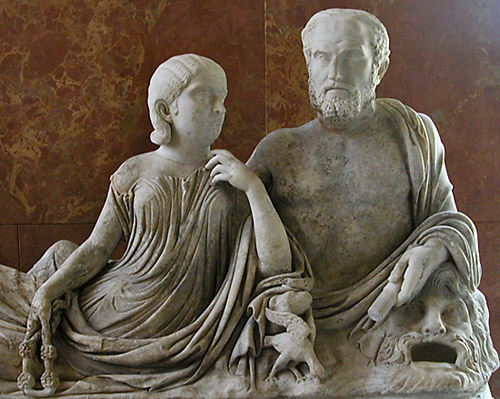 Sarcophagus lid, (detail) 235 CE
Sarcophagus lid, (detail) 235 CE
 Sarcophagus lid, (detail) 235 CE
Sarcophagus lid, (detail) 235 CE
Leuconoe is at the center of a poem known chiefly for the Epicurean ethic embedded in its famous injunction carpe diem. Was she an actual woman or a poetic construct? What relationship did she have to the poet? Why is she present in the poem? Is the poet reflecting on or reacting to an actual event? Or is Leuconoe a literary allusion, a counterpart to Diotima, the learned Greek priestess whom Socrates names as his instructor about Love in Plato's Symposium? While Leuconoe is instructed rather than instructing, Horace assumes a level of knowledge on her part that enables her to appreciate his poetic ideals. Like Horatian poetry, which combines elements of Greek lyric and epigram with Roman intellectual, political, religious, and social values, Leuconoe is an exotic hybrid of Greek and Roman qualities. Named but otherwise unknown, she offers intriguing associations with the poem's complex images and ideas about what constitutes the good life. Her name is a compound of two Greek words, leukos (white, pallid, pure) and nous (mind, thought); it and her relationship with the poet indicate that she is a slave or a freedwoman (see names) earning her living as a courtesan. Not unlike Romans of all classes, Leuconoe turned to astrology to learn the future. The poet, however, refocuses her on the present, setting her tasks that imply not a symposium setting of drinking and intellectual discussion but an intimate encounter for two. Enveloped in metaphors at once erotic, natural, and literary, Leuconoe is ambiguously servingwoman, lover, prophetess, and embodiment of Horace’s own literary aesthetics. The poem's meter is Fifth or Greater Asclepiadean (see 18th-century heptameter version).
1 Tu ne quaesieris, scire nefas, quem mihi, quem tibi
finem di dederint, Leuconoe, nec Babylonios
temptaris numeros. Ut melius, quicquid erit, pati!
Seu pluris hiemes seu tribuit Iuppiter ultimam,
5 quae nunc oppositis debilitat pumicibus mare
Tyrrhenum: sapias, vina liques, et spatio brevi
Click on the underlined words for translation aids and commentary, which will appear in a small window. Click on the icon link![]() to the right of the text for related images and information.
to the right of the text for related images and information.